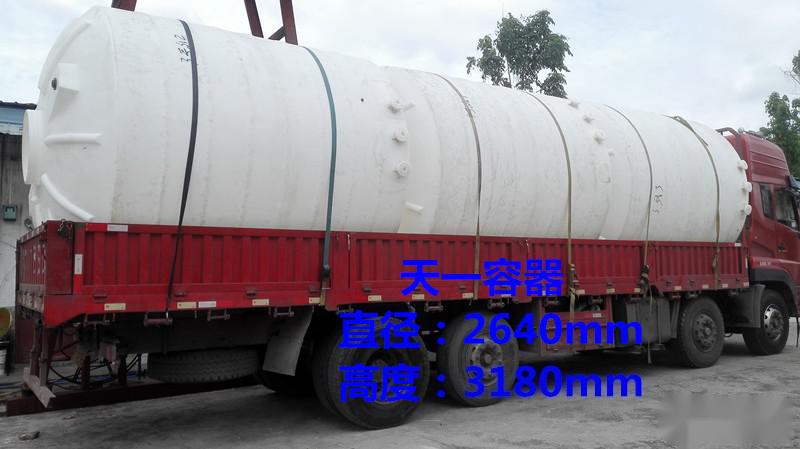1. Product Performance
1. PE plastic storage tanks are formed using rotational molding technology.
2. The softening point of the plastic used is 108℃, and the breaking point is -70℃, so it can generally be used to hold liquids at temperatures from -40℃ to 70℃. If the liquid temperature exceeds 70℃, a metal reinforcement sleeve should be installed to prevent the storage tank from softening and deforming. If the storage tank is used for chemical reactions or dilution, corresponding tests should be conducted in advance to determine the reaction or dilution temperature.
3. Accessories are configured based on the customer's provided usage, including PP, PVC, ABS joints, and PP, PVC, PE flanges are available for selection. When storing acidic or alkaline substances, it is necessary to configure PVC, PP, or PE accessories and acid-resistant gaskets. When storing organic substances (especially organic solvents), non-soluble rubber gaskets should be used.
4. This product is not suitable for storing strong oxidizers and good organic solvents.
5. If it is uncertain whether a certain substance can be stored, please consult our company in a timely manner or refer to the website.
6. Other products include: PE food round barrels, food square barrels, biogas pool barrels, turnover boxes, and other plastic container products. The product comes with 2 joints for sizes 50 and below, with free installation of joints. Products can be customized with openings and processing according to customer requirements. The company uses imported food-grade PE plastic raw materials for production, with rich production experience in rotational molding and strict quality control by professional engineering technicians, and the products strictly adhere to the quality standards of the People's Republic of China.
7. The company specializes in the production of large and extra-large plastic containers, with complete processes, completed in one go. Products include PE storage tanks, chemical water tanks, mixing barrels, transport tanks, round barrels, square boxes, and PE custom processing services.
8. Plastic PE chemical storage tanks refer to the series of seamless plastic (polyethylene) storage and transport equipment, which is one of the three major series of storage tanks. This series of products has unique modified formulas that enhance polyethylene's (PE) advantages, including seamless, leak-proof, non-toxic, lightweight, aging-resistant, impact-resistant, corrosion-resistant, long service life, and compliance with hygiene standards.
9. Plastic PE storage tanks are formed in one piece, seamless, and have a complete process. The interior and exterior of the containers are smooth, aesthetically pleasing, non-toxic, odorless, acid and alkali resistant, high-temperature resistant (below 80℃), and freeze-resistant (-40℃). They are widely used in numerous industries such as electronics, chemicals, textile dyeing, acid washing and electroplating, and environmental sanitation.
10. The advantages of plastic PE storage tanks include hygiene, safety, lightweight, and easy installation, making them an ideal choice for storing and transporting chemical liquids such as acids and alkalis.
2. Installation and Usage Instructions
1. The foundation for installing the storage tank must be level and able to withstand the corresponding pressure. If using a steel structure, the gaps must not be too large, and wood or iron boards should be laid on top.
2. When the storage tank is storing chemical substances, there should be a good drainage ditch and dilution device around the site.
3. Since the bottom of the tank inevitably bulges inward to form a dome shape during molding, the foundation should be shaped similarly to the dome (it is recommended to use sand on a level foundation to create a corresponding dome shape that matches the bottom of the storage tank).
4. Safety precautions should be taken when installing large-scale storage tanks; it is advisable to use a crane. If unsure how to proceed, please contact us.
5. Plastic joints are tightened when leaving the factory, but they may loosen during transportation and handling, so the sealing performance of the joints should be checked before use. Liquid should be poured over the joint area to observe for leaks. For storage tanks used for chemical liquids, a water test for leaks should be conducted to prevent significant losses.
6. Pipes connected to the lower joints or flanges of the storage tank should be perpendicular to the tank wall, using flexible connections to avoid damage and leakage due to uneven expansion of the tank wall when filled with liquid, which may severely damage both the joint and the tank body.
7. When the inlet is higher than the bottom of the tank, the inlet should be bent toward the tank wall, allowing the incoming liquid to flow down along the tank wall, minimizing impact on the bottom.
8. For large-capacity storage tanks (over 20 cubic meters), metal reinforcement sleeves can be used to limit the expansion deformation at the joint area, thus preventing cracking at the openings.
9. Please contact our company again when changing the liquid being stored.
3. Main Products
Nanning Tianyi's main products include: PE storage tanks, plastic storage tanks, chemical storage tanks, anti-corrosion storage tanks, plastic water towers, cone bottom barrels, plastic round barrels, plastic square boxes, dosing boxes, floating boxes, anti-collision barrels, water horses, acid washing tank processing, steel-lined plastic products, plastic containers, plastic custom welding, transport tank welding, fiberglass waste gas treatment equipment, and large fiberglass containers, as well as processing of various custom-shaped parts.
3. Company Product Photos

















